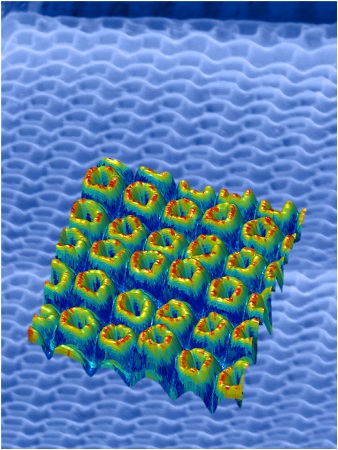A research team from the Georgia Institute of Technology has devised a ‘soft template infiltration’ process for synthesizing free-standing piezoelectric ferroelectric nanotubes and other nanostructures using PZT (PbZr0.52Ti0.48O3), a material known for its giant piezoelectric response.
 Composite scanning electron microscope (SEM) image of PZT nanotube arrays and their piezoelectric response as measured by band-excitation PFM (BE-PFM). (Image courtesy of Ashley Bernal and Nazanin Bassiri-Gharb)
Composite scanning electron microscope (SEM) image of PZT nanotube arrays and their piezoelectric response as measured by band-excitation PFM (BE-PFM). (Image courtesy of Ashley Bernal and Nazanin Bassiri-Gharb)
This novel technique is capable of producing ferroelectric nanostructures with customized shapes, location and pattern difference across the same substrate. These nanostructures demonstrate a piezoelectric response equivalent to that of large-size thin films made of PZT.
During the fabrication of the ferroelectric nanotubes, a negative electron-beam resist material was spin-coated over a silicon substrate. Then, electron-beam lithography was used to create a template atop which an aluminum oxide thin layer was added utilizing atomic layer deposition. The template was then submerged under vacuum in an ultrasound bath having a predecessor solution for PZT.
Pyrolysis of the structures then carried out at 300°C followed by annealing by a two-step heat treatment process at 600-800°C for decomposing the polymer substrate and crystallizing the material. The process synthesized free-standing PZT nanotubes linked by the original aluminum oxide thin layer. Solid nanowires or nanorods can be produced in place of hollow nanotubes by increasing the quantity of chemical infiltration.
This advanced technique paves the way to fabricate actively-tunable micropumps, micromotors, energy harvesters, terahertz emitters, phononic and photonic crystals, and nanoelectromechanical transducers, actuators and sensors using the PZT material.
The research team was also able to accurately measure the nanoscale piezoelectric properties of the ferroelectric nanostructures with the help of an Oak Ridge National Laboratory-developed characterization technique called the band-excitation piezoresponse force microscopy.
Besides providing accurate control over location, the soft template infiltration technique fabricated piezoelectrically active nanotubes with high aspect ratios of up to 5:1 from PZT. Another interesting fact about these ferroelectric nanotubes is their properties, including dielectric characteristics, optical responses, shape and size, can be controlled by outside forces even after their production.
The study findings were reported online in the journal Advanced Materials.